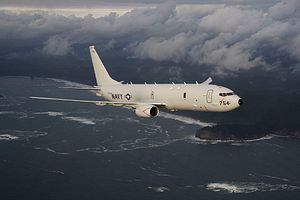The United States Navy (USN) has awarded U.S. aircraft maker Boeing a $2.2 billion contract modification for the construction of 17 new P-8A Poseidon Maritime Surveillance Aircraft, according to a U.S. Department of Defense press release.
“The Boeing Co. (…) is being awarded a $2,196,638,752 modification to a previously awarded fixed-price, cost-plus-fixed-fee contract (…) for the manufacture and delivery of 17 Lot 8 full-rate production P-8A aircraft for the Navy,” the statement reads.
The contract includes 11 aircraft for the USN, four for the Royal Australian Air Force (RAAF), and two for the Royal Air Force (RAF).
Work on the new aircraft will occur through December 2020. The contract also covers lead parts for the USN, foreign military sales customers, and cooperative agreement partners. Overall, the USN is slated to receive 78 P-8As, with 53 delivered so far.
The P-8A is a military variant of Boeing’s Next-Generation 737-800 commercial aircraft featuring advanced anti-submarine, anti-surface warfare, and intelligence, surveillance, and reconnaissance capabilities. It was designed by Boeing to replace the USN’s aging fleet of Lockheed P-3 Orion anti-submarine/maritime surveillance aircraft.
According to Boeing, the P-8A “has twice the sonobuoy processing capability and can carry 30 percent more sonobuoys than any maritime patrol and reconnaissance aircraft currently flying.” The aircraft is also capable of controlling a number of unmanned aerial vehicles to extend sensor reach.
Furthermore, I noted in February 2016:
The P-8A has a range of up to 7,242 kilometers (4,500 miles) without refueling, reaches speeds of up to 490 knots, and can fly in the “harshest maritime flight regimes, including extended operations in icing environments,” Boeing boasts.
The aircraft can carry several types of bombs, Raytheon Mark 54 lightweight torpedoes (…), mines, and depth charges, in addition to air-to-surface missiles installed on the underwing hardpoints.
The new aircraft are also slated to be armed with the so-called High Altitude Anti-Submarine Warfare Weapon Capability (HAAWC), a new torpedo upgrade that can release a MK54 torpedo, fitted with an air-launched accessory kit that includes a GPS guidance system and folding wings, from altitudes of 30,000 feet (9,100 meters) or higher — it essentially turns the torpedoes into glide bombs.
HAAWC would permit the P-8A to operate from higher altitudes during anti-submarine warfare operations, avoiding detection by enemy submarines. In comparison, P-3 Orion aircraft have to descend to an altitude of around 100 feet to release their torpedoes and engage targets exposing them to low-altitude anti-aircraft defenses.
According to Flight Global, HAAWC is currently undergoing separation tests from the P-8A and a decision to commence low-rate production will be made shortly. A first guided flight test is planned for later in the year. HAAWC would also be available for the Royal Australian Air Force and the Indian Air Force, both of which operate variants of Boeing’s sub-hunting aicraft.
































